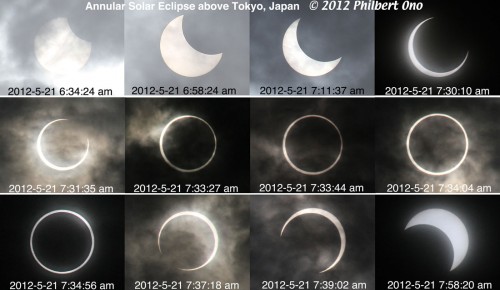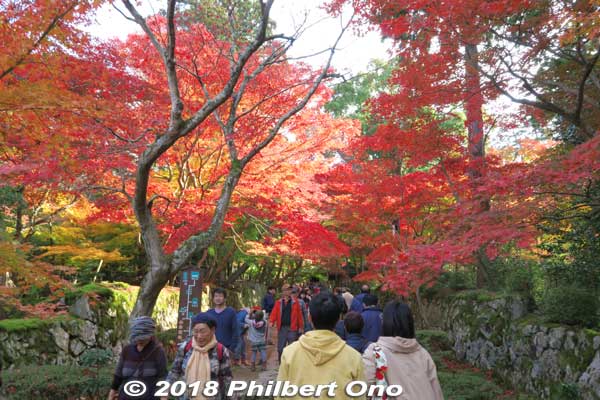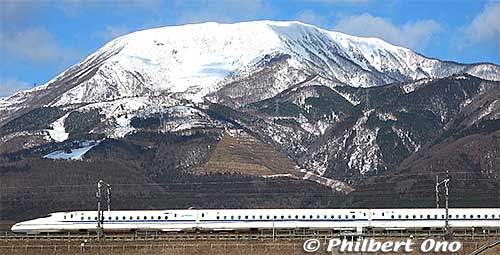
A large swath of Japan was treated to an annular solar eclipse at around 7:30 am on May 21, 2012. People in southeastern Shiga Prefecture joined the masses in Tokyo, Nagoya, and Osaka to view the rare annular eclipse over most of Japan’s Pacific Ocean side. The rest of Japan could at least see a partial eclipse. An annular solar eclipse occurs when the moon comes between the sun and Earth and casts a shadow on Earth. The moon is farther away from Earth than during a total solar eclipse, so it does not cover the sun totally, exposing only a solar ring. In Japanese, an annular solar eclipse is called kinkan nisshoku (金環日食), literally “devoured sun with golden ring.”
People in the southeastern half of Shiga Prefecture could see the annular solar eclipse with the perfect ring of fire. The area from Maibara to Otsu was close to the northern boundary of the annular shadow path. Beyond that in Nagahama and Takashima, people could only see a partial solar eclipse. The annular ring could be seen for about 5 minutes at the center of the annular shadow path which went through central Tokyo. The further away you are from shadow’s center, the less time the ring appears.
In Shiga, the ring appeared for a maximum of about 3 minutes depending on the location. It was around 3 minutes in Koka and Higashi-Omi starting at 7:29 am. People in central Otsu saw it for about 2 minutes from 7:29 am. In Maibara, it was about a minute or less at 7:31 am. Nagahama and Takashima were outside the annular shadow and could only see a partial solar eclipse (a crescent sun). The last time an annular solar eclipse occurred in Shiga Prefecture was 282 years ago. Gee, I wonder how they viewed it at the time, if they even knew about it.
I was in Tokyo and photographed the eclipse about 1.5 km from the shadow’s center so I had the maximum 5 minutes to view and photograph the ring. We were lucky to have fleeting breaks in the veil of clouds during the eclipse. The clouds actually made it look more dramatic. A cloudless sky would create a totally black background in the photo. The ring appeared at 7:34 am in Tokyo. The last time this occurred in Tokyo was 173 years ago in 1839. The next annular solar eclipse in Tokyo will be three centuries from now. Too bad about Mt. Fuji being totally fogged over. People up there saw nothing. Map of the annular eclipse path: http://eclipse.gsfc.nasa.gov/SEgoogle/SEgoogle2001/SE2012May20Agoogle.html
It was also cloudy in Shiga at the time of the eclipse, but the sun did peep out of the clouds now and then and most got a chance to see the ring. Koka was the first to see the eclipse in Shiga starting at 6:17 am. Many school kids in Shiga went to school about an hour early and gathered on the school grounds to view the eclipse using solar eclipse sunglasses. Earth science students at Maibara High School used high-powered telescopes to successfully observe and photograph Baily’s beads which appear at the moment when the ring forms. Since Maibara is along the fringe of the annular shadow, it was a prime spot to view Baily’s beads. The students even appeared on national TV news that day on NHK at 7 pm.
The temperature dropped slightly by 0.6 C to 1 C in Shiga during the eclipse. The sky also became slightly darker during the peak, but it was still very bright. The photos look dark because of the dark filter on the lens. You cannot see the ring without a dark filter or solar eclipse glasses. Even at the peak of the eclipse, the sun was still a bright spot in the sky. Some people in Japan got married or engaged or gave a wedding or engagement ring to their fiance during the eclipse. To me, it looked like a heavenly angel’s halo without the angel. It certainly was worth getting up early to see it.





